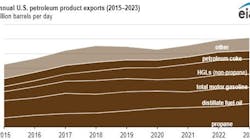Sam Fletcher
OGJ Senior Writer
HOUSTON, Jan. 21 -- Oil prices continued to retreat Jan. 20, with the expiring February contract down 2.2% to below $90/bbl, but the front-month natural gas contract rebounded, up 2.7% to a 5-month high in the New York market as colder-than-normal temperatures triggered a larger-than expected draw of gas from US storage.
The drop in oil prices was “a correction, which was perhaps overdue,” said James Zhang at Standard New York Securities Inc., the Standard Bank Group. “The price broke out of the narrow trading range seen during the last six sessions and effectively gave back all the gains from the outage of the Trans-Alaska Pipeline System (OGJ Online, Jan. 18, 2011).”
In Houston, analysts at Raymond James & Associates Inc. reported, “Crude oil and the broader markets fell early and hard yesterday as fourth quarter Chinese gross domestic product growth far exceeded estimates, leading to speculation that the country's government will tighten monetary policy in order to cool excessive demand and combat runaway inflation.”
A bearish government report on US oil inventories helped pull down crude prices even further, they said.
The Energy Information Administration said commercial US crude inventories increased 2.6 million bbl to 335.7 million bbl in the week ended Jan. 14. The Wall Street consensus was for a decline of 500,000 bbl. Gasoline stocks jumped by 4.4 million bbl to 227.7 million bbl, outstripping a consensus for a 2.5 million bbl build. Finished gasoline inventories decreased while blending components inventories increased. Distillate fuel inventories climbed by 1 million bbl to 165.8 million bbl, exactly as analysts had predicted (OGJ Online, Jan. 20, 2011).
EIA also reported the withdrawal of 243 bcf of natural gas from US underground storage last week, exceeding the Wall Street consensus of 230 bcf. That left 2.7 tcf of gas in storage, 74 bcf more than the same period last year and 51 bcf above the 5-year average. Temperatures in the eastern US are forecast to continue below normal for the next 10 days. With cold weather supporting gas prices, “the storage outlook for the summer is looking less bearish,” said Adam Sieminski, chief energy economist, Deutsche Bank AG, Washington.
Energy stocks followed crude and the broader markets into the red Jan. 20. However prices on crude, gas, and corporate stocks were up in early trading Jan. 21, “following positive confidence reports and successful bond sales amongst debt-laden European countries,” said Raymond James analysts.
Zhang noted, “A 600,000 bbl drop of crude inventory at Cushing, Okla., failed to narrow the West Texas Intermediate-Brent spread, with the front month spread widening by 26¢/bbl instead.”
However, last week’s decline in crude inventories at Cushing “would not fall outside of seasonal patterns,” said Olivier Jakob at Petromatrix, Zug, Switzerland. Moreover, he said, “With preliminary indications showing a build in Cushing for next week, we cannot bet on further seasonal draws. A reason for that is that after a series of pipeline disruptions in the fourth quarter, the imports of Canadian crude oil to the US are increasing. …Weekly crude oil imports from Canada were at the highest level since June.”
Among petroleum products, “the light-heavy spread has widened dramatically as reflected in the gas oil premium to fuel oil, propelled by colder-than-normal weather across the northern hemisphere,” Sieminski said. “We had predicted this based on the expectation of a structural widening of the spread in line with forecasts for global economic growth this year that would boost demand for gasoil at the expense of fuel oil.”
Zhang said, “For the coming week, we expect markets to enter a period of downward correction, barring any more supply disruptions. The recent supply disruption in Alaska is now settling down. Winter demand is also set to wane in a few weeks. The latest…inventory report confirmed that US inventories have started the seasonal build up, which will continue until June. However, Chinese oil demand is set to remain strong, although China’s monetary policy will also keep the market on its toes. In addition, the US is likely to continue with its positive economic news, which should continue to support the market.”
Energy prices
The February contract for benchmark US light, sweet crudes dropped $2 to $88.86/bbl on the New York Mercantile Exchange. The March contract fell $2.22 to $89.59/bbl. On the US spot market, WTI at Cushing was down $2 to $88.86/bbl. Heating oil for February delivery declined 3.3¢ to $2.62/gal on NYMEX. Reformulated blend stock for oxygenate blending for the same month retreated 5.91¢ to $2.42/gal.
The February natural gas contract changed direction, however, and climbed 13.4¢ to $4.70/MMbtu on NYMEX. On the US spot market, gas at Henry Hub, La., continued to rise, up 12.5¢ to $4.61/MMbtu.
In London, the March IPE contract for North Sea Brent crude dropped $1.58 to $96.58/bbl. Gas oil for February fell $15 to $806.25/tonne.
The average price for the Organization of Petroleum Exporting Countries' basket of 12 reference crudes lost $1.04 to $92.95/bbl.
Contact Sam Fletcher at [email protected].

